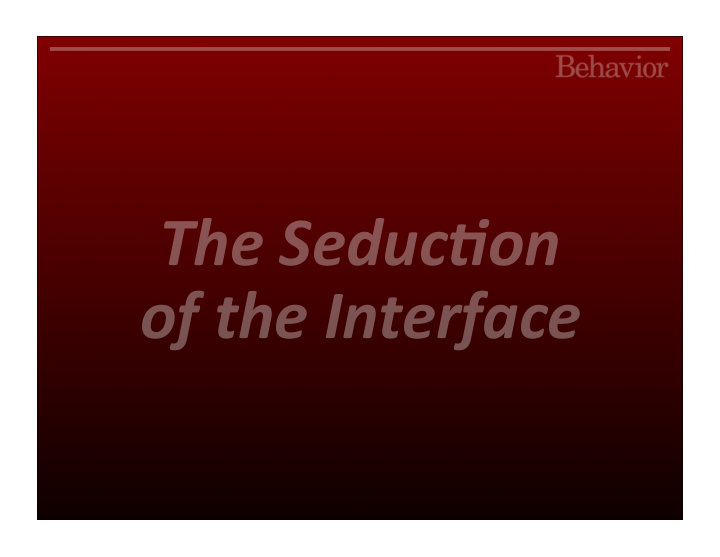



The Seduc)on of the Interface
seduc&on
seduc&on
Christopher Fahey graphpaper.com
seduc&on
merchandising
merchandising vs. marke&ng
marke&ng
merchandising The strategy and implementa1on of how a product is presented to customers as they decide whether or not to purchase.
merchandising Three 1ers of Merchandising: 1.Selling Contexts 2.Packaging 3.Products that Sell Themselves
1. Selling Contexts
Selling Contexts E‐commerce Selling Contexts • S1ll learning how to op1mize placement, pricing, sequences, nomenclature.
Selling Contexts E‐commerce Selling Context Innova1ons • Automated recommenda1ons • “People like you bought” • Wish lists • Robust UI product previews
2. Packaging
Packaging = Selling Context?
Don’t Think of Your Product’s “Box”
3. Products that Sell Themselves
merchandising The strategy and implementa1on of how a product is presented to customers as they decide whether or not to purchase.
beyond merchandising
marke&ng vs. design
marke&ng vs. design
marke&ng = design
design
“web‐centric”
pleasure
sensory experiences
pleasure “AMrac&ve things work beMer.” ‐ Don Norman, Emo+onal Design
web 2.0
web 2.0 How the design of Web 2.0 user experiences change how products are marketed: • Subscrip1on‐based product models • Vibrant communi1es around and within products • Fully‐func1onal demos, easily distributed and managed • Free!
conversion
SUBMIT
conversion is obsolete
conversion connec&on
seduc&on
falling in love
The Three Stages of Seduc&on 1. Inspire their aXen1on, interest and desire 2. Draw them in (lead them astray) 3. Capture their ongoing devo1on
Stage One: Inspire their a7en)on, interest and desire
choose your vic&m
Robert Greene’s “Vic&ms” • The Reformed Rake or Siren • The Professor • The Professor • The Disappointed Dreamer • The Beauty • The Beauty • The Pampered Royal • The Aging Baby • The Aging Baby • The New Prude • The Rescuer • The Rescuer • The Crushed Star • The Roué • The Roué • The Novice • The Idol Worshipper • The Conqueror • The Sensualist • The Idol Worshipper • The Exo1c Fe1shist • The Lonely Leader • The Sensualist • The Drama Queen • The Floa1ng Gender • The Lonely Leader • The Floa1ng Gender Source: The Art of Seduction by Robert Greene
Mark & Pearson’s “Archetypes” • The Innocent • The Regular Guy/Gal • The Professor • The Explorer • The Lover • The Beauty • The Sage • The Jester • The Aging Baby • The Hero • The Caregiver • The Rescuer • The Outlaw • The Creator • The Roué • The Magician • The Ruler • The Idol Worshipper • The Sensualist • The Lonely Leader • The Floa1ng Gender Source: The Hero and the Outlaw by Margaret Mark and Carol Pearson
Yahoo’s “Compe&&ve Spectrum” Source: http://developer.yahoo.com/ypatterns/pattern.php?pattern=competitive
Make up your own! Detect your users’ emo&onal quali&es and speak to them in your UI design. Examples: • Rebelliousness and difference • Power and Control • Modesty • Avoidance of embarrassment • Authen1city • Acceptance in one’s social group • Aspira1on to a new class role • Fun and release from stress
User Personas
User Personas Persona Usage Guidelines: • Personas of any kind should be informed by research. • Even the smallest amount of research helps. It’s not a bad thing if the designers themselves do some or all of the research. • The discussions a2er the research are almost more important. • The journey is more important than the result. • Differen&ate seduc&ve quali&es from genuine user func&onal needs.
make the first move
make the first move • Use motion • Animation • Video demos • Use words • Speak directly to the user • Tell them what they can do to do specifically • Careful with audio!
create a sense of mystery
the first move • Blah
appear desireable
appear desirable Present Tes1monials • Not just media tes1monials • But real user tes1monials, too
appear desirable Present Tes1monials • Not just media tes1monials • But real user tes1monials, too
flaMer them
tempt them
Stage Two: Draw Them In (Lead Them Astray)
dazzle them with wonder
Robert Greene’s “Vic&ms” • The Reformed Rake or Siren • The Professor • The Professor • The Disappointed Dreamer • The Beauty • The Beauty • The Pampered Royal • The Aging Baby • The Aging Baby • The New Prude • The Rescuer • The Rescuer • The Crushed Star • The Roué • The Roué • The Novice • The Idol Worshipper • The Conqueror • The Sensualist • The Idol Worshipper • The Exo1c Fe1shist • The Lonely Leader • The Sensualist • The Drama Queen • The Floa1ng Gender • The Lonely Leader • The Floa1ng Gender Source: The Art of Seduction by Robert Greene
have a sense of humor
be stylish
affordances of desire
distract them from their responsibili&es
Stage Three: Capture Their Ongoing Devo)on
con&nually grow
the design process
goals, scenarios and paths
goals, scenarios and paths
goals Your users have goals. Write them down and use them to guide and inspire your design. • They will “muddle through” the hard parts if the end result is s1ll visible to them. • Use tempta1on and encouragement to keep them going. • Don’t lie: Be honest about how close to their goals they really are.
• Remove obstacles
plan for delight
Recommend
More recommend